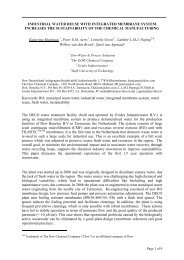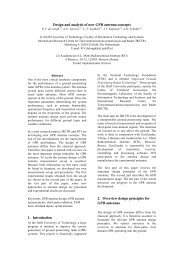CHAPTER 5 CONCRETE PAVEMENTS - TU Delft
CHAPTER 5 CONCRETE PAVEMENTS - TU Delft
CHAPTER 5 CONCRETE PAVEMENTS - TU Delft
Create successful ePaper yourself
Turn your PDF publications into a flip-book with our unique Google optimized e-Paper software.
5.3.3 Stresses due to temperature variations:<br />
Temperature variations lead to stresses in the concrete top layer. These stresses can<br />
be distinguished into (figure 5.8):<br />
1. stresses due to a temperature change ∆T which is constant over the thickness<br />
of the concrete layer<br />
2. stresses due to a temperature gradient ∆t which is constant over the thickness<br />
of the concrete layer<br />
3. stresses due to an irregular temperature over the thickness of the concrete<br />
layer.<br />
Figure 5.8: Temperature in the concrete toplayer in case of heating at the surface.<br />
A regular temperature increase or decrease ∆T leads to compressive and tensile<br />
stresses respectively in the concrete toplayer due to friction over the underlying layer.<br />
However, for plain concrete pavements (that generally consist of slabs with both a<br />
length and a width smaller than 5 m (roads) or 7.5 m (airports) these stresses are<br />
such small that they can be neglected.<br />
The irregular temperature results in internal concrete stresses, which are only<br />
relevant for very thick concrete slabs. For normal concrete slab thicknesses they also<br />
can be neglected.<br />
On the contrary, the temperature gradients ∆t cause flexural stresses in the concrete<br />
slab, which are for plain concrete pavements in the same order of magnitude as<br />
those caused by the traffic loadings, and thus cannot be neglected at all.<br />
The temperature gradient ∆t is defined as (figure 5.8):<br />
T Tb<br />
∆ t =<br />
(5.2)<br />
h<br />
t −<br />
where: Tt = temperature (°C) at the top of the concrete layer<br />
Tb = temperature (°C) at the bottom of the concrete layer<br />
h = thickness (mm) of the concrete layer<br />
For the structural design of plain concrete pavements in The Netherlands only the<br />
positive temperature gradients are relevant because:<br />
171











